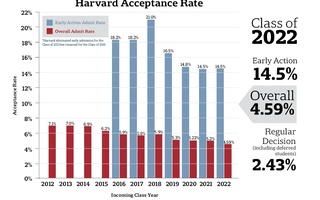{shortcode-ed803060924ba752fa33d822c350eeba975f787e} The College notified 964 students of their acceptance into the Class of 2022 Tuesday, representing 14.5 percent of the 6,630 applicants for early admission.
This year’s acceptance rate for early applicants is roughly equal to last year’s rate—the lowest since the return of the early admission program in 2011. The overall early applicant pool was the largest since the program’s reinstatement.
“The one thing we can say with certainty is that the numbers rose this year,” William R. Fitzsimmons ’67, Dean of Admissions and Financial Aid, said in an interview Tuesday. “In general terms, it appears that more institutions had increases than the reverse… Early admission, in one form or another, is the new normal.”
In addition to the 964 students accepted early, 4,882 students were deferred to the regular applicant pool and 611 students were rejected, reflecting 73.6 and 9.2 percent of the early applicant pool, respectively. The remaining 173 applications were marked incomplete and will be reviewed alongside regular decision applications when completed.
In September, Fitzsimmons announced that the College would accept fewer students into the Class of 2022 after a record-high yield produced crowding in freshman dorms this year. The Admissions Office is aiming to eventually admit “40 to 50 to maybe 100 people” off the Class of 2022 waitlist this year, Fitzsimmons said at the time.{shortcode-071f2faf1d6bbf0056db6f46f023ddd9b96a0b7b}
Despite the relatively large pool of students accepted early, Fitzsimmons said the admissions office “will certainly be mindful of coming in on target” for class size when reviewing the regular applicant pool.
The group of early admits to the Class of 2022 reflects an overall increase in non-white students from previous years. African American students comprise 13.9 percent of early admits, up 1.3 percentage points from last year, and the percentage of Latino students increased slightly to 9.8 percent of the early admit class. Native American and Native Hawaiian students make up 1.8 percent of early admits combined, up marginally from 1.1 percent last year.
The percentage of Asian American early admits grew the most, increasing from 21.7 percent last year to 24.2 percent this year. Harvard is currently facing scrutiny from both the Department of Justice and a separate lawsuit accusing the College of discriminating against Asian Americans in its undergraduate admissions processes.
Women comprise 47 percent of admitted early applicants, a small decrease from 48 percent for the Class of 2021.
Additionally, the College saw an increase in economic diversity among both applicants and admits. So far, almost 58 percent of admitted students have applied for financial aid—up slightly from last year—and roughly 13 percent have requested application fee waivers, an increase from 10.7 percent for the early admitted Class of 2021. First-generation college students make up almost 10.6 percent of early admits, compared to 8.7 percent last year.
According to Fitzsimmons, the pool of early applicants is typically less diverse than that of regular applicants, though he believes recent efforts to increase awareness of the early admissions program have served to mitigate some of the disparities.
“Traditionally, early programs have tended not to reflect the excellence and diversity that you see out in the world, so one of the real pushes over the past decade or so—and part of it was giving it up and then bringing it back—is to make certain that people from all of those backgrounds do consider early,” Fitzsimmons said. “We’re delighted to see that we had greater economic and ethnic diversity not just in the pool, but in the admitted group.”
Although Fitzsimmons said earlier this semester that he was unsure about how natural disasters could affect prospective applicants earlier this semester, the geographic and regional distribution of students remained similar to previous years. Among admitted students, 10.2 percent applied from outside the United States, including 2.3 percent of students who applied from Canada.
Also during Tuesday’s interview, Fitzsimmons addressed concerns that alumni involvement in recruitment and admissions processes could have unintended consequences. In early November, the Chronicle of Higher Education reported, a San Diego-area alumnus accidentally sent private applicant information, including interview ratings, to several prospective students in the area.
Fitzsimmons said he continues to support the role of alumni in the Admissions Office’s work.
“We have had this robust alumni network helping us for many, many years, and I think it really makes an enormous difference,” Fitzsimmons said, “Certainly with our high yield on admitted students, but also on the excellence and the quality of the people who end up applying.”
Students applying regular decision to the College have until Jan. 1 to submit their applications. Decisions will be released to regular decision applicants in late March, and all admitted students have until May 1 to reply to the College.
—Staff writer William S. Flanagan can be reached at will.flanagan@thecrimson.com. Follow him on Twitter @willflan21.
—Staff writer Michael E. Xie can be reached at michael.xie@thecrimson.com. Follow him on Twitter @MichaelEXie1.
















